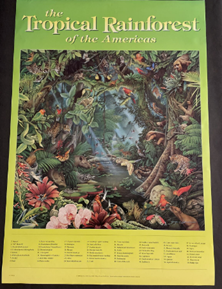My first recollection of environmental education comes from my fourth-grade book fair. Do you remember the excitement you had walking into the Scholastic Book Fair at your elementary school? Well, I do! For me it was a collection of feelings—excitement, wonder, and a pinch of panic. Excitement of walking up and down the rows of books, the wonderment of topics that I could discover, and the panic of staying within my budget. It was the early 90s, pre-internet, and I had just walked into a new world. I wanted one of everything!
I can’t tell you what book I purchased that day, but what I can tell you is that I made a tough decision. I purchased a poster; one which hung on my bedroom wall for years! Did I go with the 90210 Luke Perry, New Kids on the Block, or the tropical rainforest poster? Surprise, surprise, I chose the tropical rainforest. I was fascinated with the beautifully illustrated plants and animals. Did this place really exist? If so, I wanted to go there one day! I would spend years looking at this poster, learning the names of all the plants and animals, and reading the descriptions of the tree canopy and under-story. This tropical rainforest seemed like a distant make-believe world. I hadn’t realized at the time, but I was learning about an ecosystem.
World Environment Education Day is on January 26 every year. When researching the focus of this day, which is to “celebrate the ongoing work of countless individuals and organizations across the globe who are actively working towards protecting our environment,” I was immediately brought back to that tropical rainforest poster.
Fast-forward thirty years from that book fair, and the little girl who purchase that beautifully illustrated poster found her way to college, majoring in plant science. During her college studies, she spent a summer semester traveling around Australia studying the various ecosystems through environmental education. In her professional life, she found work with Pennsylvania’s Bureau of Forestry as an urban forester, and then the Bureau of State Parks in the recreation and interpretation field. Pre-COVID, she was selected to participate in an all-female outdoor recreation leadership school in Costa Rica. Do you think that tropical poster had any influence in forming her education and professional path? Well, I sure do!

A photo of “The Tropical Rainforests of the America’s” / Photo image courtesy of eBay and Safari Ltd.
I share my story with you to foster continued interest in the natural world. No matter your age, stay curious about our environment. Encourage the youth in your life to discover the plants and wildlife in their neighborhood. Pennsylvania is a beautiful state, rich in diversity of its people and ecosystems.
Wondering how to connect with the outdoors in Pennsylvania? Consider attending one of the many unique environmental education programs offered at Pennsylvania state parks and forests. These fascinating and engaging programs are led by knowledgeable and friendly environmental educators and free to attend! Visit https://events.dcnr.pa.gov/ to discover upcoming events and trainings.
Lastly, as the youth in your life contemplate future careers, consider sharing with them the many opportunities DCNR can offer. Pennsylvania needs future environmental educators, engineers, geologists, GIS specialists, land managers, lawyers, rangers, researchers, and tradespeople. To learn more about internships with DCNR, visit https://www.dcnr.pa.gov/internships/pages/default.aspx.
Written by Christine Ticehurst, DCNR Bureau of State Parks, Natural Resource Program Specialist




